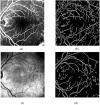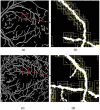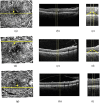Registration of fluorescein angiography and optical coherence tomography images of curved retina via scanning laser ophthalmoscopy photographs
- PMID: 33014544
- PMCID: PMC7510895
- DOI: 10.1364/BOE.395784
Registration of fluorescein angiography and optical coherence tomography images of curved retina via scanning laser ophthalmoscopy photographs
Abstract
Accurate and automatic registration of multimodal retinal images such as fluorescein angiography (FA) and optical coherence tomography (OCT) enables utilization of supplementary information. FA is a gold standard imaging modality that depicts neurovascular structure of retina and is used for diagnosing neurovascular-related diseases such as diabetic retinopathy (DR). Unlike FA, OCT is non-invasive retinal imaging modality that provides cross-sectional data of retina. Due to differences in contrast, resolution and brightness of multimodal retinal images, the images resulted from vessel extraction of image pairs are not exactly the same. Also, prevalent feature detection, extraction and matching schemes do not result in perfect matches. In addition, the relationships between retinal image pairs are usually modeled by affine transformation, which cannot generate accurate alignments due to the non-planar retina surface. In this paper, a precise registration scheme is proposed to align FA and OCT images via scanning laser ophthalmoscopy (SLO) photographs as intermediate images. For this purpose, first a retinal vessel segmentation is applied to extract main blood vessels from the FA and SLO images. Next, a novel global registration is proposed based on the Gaussian model for curved surface of retina. For doing so, first a global rigid transformation is applied to FA vessel-map image using a new feature-based method to align it with SLO vessel-map photograph, in a way that outlier matched features resulted from not-perfect vessel segmentation are completely eliminated. After that, the transformed image is globally registered again considering Gaussian model for curved surface of retina to improve the precision of the previous step. Eventually a local non-rigid transformation is exploited to register two images perfectly. The experimental results indicate the presented scheme is more precise compared to other registration methods.
© 2020 Optical Society of America under the terms of the OSA Open Access Publishing Agreement.
Conflict of interest statement
The authors declare that there are no conflicts of interest related to this article.
Figures
















Similar articles
-
Optical coherence tomography angiography (OCT-A) in an animal model of laser-induced choroidal neovascularization.Exp Eye Res. 2019 Jul;184:162-171. doi: 10.1016/j.exer.2019.04.002. Epub 2019 Apr 16. Exp Eye Res. 2019. PMID: 31002822
-
Non-rigid registration of Fluorescein Angiography and Optical Coherence Tomography via scanning laser ophthalmoscope imaging.Annu Int Conf IEEE Eng Med Biol Soc. 2017 Jul;2017:4415-4418. doi: 10.1109/EMBC.2017.8037835. Annu Int Conf IEEE Eng Med Biol Soc. 2017. PMID: 29060876
-
Correlation between spectral domain optical coherence tomography findings and fluorescein angiography patterns in diabetic macular edema.Ophthalmology. 2009 Jun;116(6):1158-67. doi: 10.1016/j.ophtha.2008.12.063. Epub 2009 Apr 23. Ophthalmology. 2009. PMID: 19395034
-
[New examination methods for macular disorders--application of diagnosis and treatment].Nippon Ganka Gakkai Zasshi. 2000 Dec;104(12):899-942. Nippon Ganka Gakkai Zasshi. 2000. PMID: 11193944 Review. Japanese.
-
Progress of Imaging in Diabetic Retinopathy-From the Past to the Present.Diagnostics (Basel). 2022 Jul 11;12(7):1684. doi: 10.3390/diagnostics12071684. Diagnostics (Basel). 2022. PMID: 35885588 Free PMC article. Review.
Cited by
-
Generating large field of view en-face projection images from intra-acquisition motion compensated volumetric optical coherence tomography data.Biomed Opt Express. 2020 Nov 4;11(12):6881-6904. doi: 10.1364/BOE.404738. eCollection 2020 Dec 1. Biomed Opt Express. 2020. PMID: 33408968 Free PMC article.
-
Development and evaluation of customized software to automatically align macula and optic disc centered scanning laser ophthalmoscope fundus images.PeerJ Comput Sci. 2025 Apr 1;11:e2621. doi: 10.7717/peerj-cs.2621. eCollection 2025. PeerJ Comput Sci. 2025. PMID: 40567799 Free PMC article.
-
Adaptive optics scanning laser ophthalmoscopy and optical coherence tomography (AO-SLO-OCT) system for in vivo mouse retina imaging.Biomed Opt Express. 2022 Dec 19;14(1):299-314. doi: 10.1364/BOE.473447. eCollection 2023 Jan 1. Biomed Opt Express. 2022. PMID: 36698677 Free PMC article.
-
Automatic Detection of Microaneurysms in OCT Images Using Bag of Features.Comput Math Methods Med. 2022 Jul 15;2022:1233068. doi: 10.1155/2022/1233068. eCollection 2022. Comput Math Methods Med. 2022. PMID: 39279986 Free PMC article.
-
Automatic detection of microaneurysms in optical coherence tomography images of retina using convolutional neural networks and transfer learning.Sci Rep. 2022 Aug 17;12(1):13975. doi: 10.1038/s41598-022-18206-8. Sci Rep. 2022. PMID: 35978087 Free PMC article.
References
-
- Khaderi K., Ahmed K., Berry J., Labriola L., Cornwell R., “Retinal imaging modalities: advantages and limitations for clinical practice,” Retinal Physician 8 (2011).
-
- Wang H., Chhablani J., Freeman W. R., Chan C. K., Kozak I., Bartsch D.-U., Cheng L., “Characterization of diabetic microaneurysms by simultaneous fluorescein angiography and spectral-domain optical coherence tomography,” Am. J. Ophthalmol. 153(5), 861–867.e1 (2012).10.1016/j.ajo.2011.10.005 - DOI - PMC - PubMed
LinkOut - more resources
Full Text Sources
